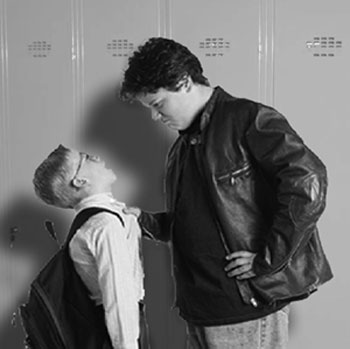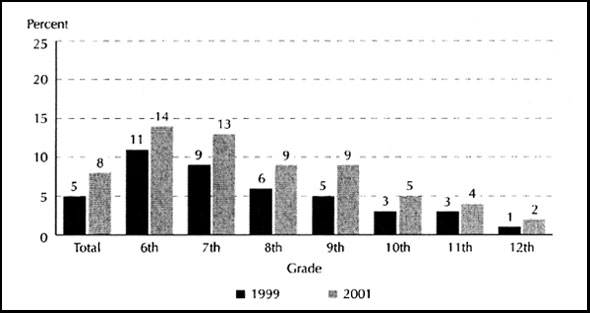| Some Things In School Are Scarier Than A Pop Quiz! |


|
A Special Report on Bullying and Hazing From David G. McDonough NYS Assembly Member |
|
||

|
||
|

Dear Friend: Ensuring that every child throughout New York state receives a first-class education is one of my top legislative priorities. Unfortunately, too many students can’t realize this goal because they’re victimized by bullying, hazing and other forms of harassing behavior. This special report highlights some shocking statistics from a study by the National Center for Education Statistics "Indicators of School Crime and Safety: 2003." Specifically, the study states that in 1999 and 2001, a majority of students were more afraid of being victimized at school than out of school. Bullying among children is defined as intentional, repeated hurtful acts, words or other behavior, such as name-calling, threatening or shunning, committed by one or more children against another. These negative acts aren’t intentionally provoked by the victims. For such acts to be defined as bullying, an imbalance in real or perceived power must exist between the bully and the victim. The term "hazing" is often misused as a synonym for harassment or bullying. While hazing can involve many behaviors that would also characterize harassment and bullying, its definition is more specific. Hazing is defined in the terms of the following core components: behavior that is humiliating, degrading, and emotionally and/or physically harmful; behavior that is expected in order to join or maintain one’s full status in a group or membership organization; and hazing can occur regardless of an individual’s willingness to participate. Clearly, this must change if our children are to receive the quality education they deserve. As a legislator, I am committed to working with teachers, administrators, parents and students to put an end to bullying, hazing and harassment once and for all. This special report details how often bullying and hazing occur and outlines a plan to prevent this unacceptable behavior. As always, I am interested in hearing your feedback on this issue. If I can ever be of assistance, please feel free to contact me. |
||
Sincerely,
Member of Assembly |
||
| What is Bullying or Hazing? |
| Bullying among children is defined as intentional, repeated hurtful acts, words or other behavior, such as name-calling, threatening or shunning, committed by one or more children against another. These negative acts aren’t intentionally provoked by the victims and, for such acts to be defined as bullying, an imbalance in real or perceived power must exist between the bully and the victim. |
|
Types of Bullying
Bullying can take many hurtful forms, including physical, verbal, emotional or sexual.
Types of Hazing Hazing activities are generally considered to be physically abusive, hazardous, and/or sexually violating. Here are a few characteristics of hazing:
|
| Facts about Bullying |
|
A report issued by the National Center for Education Statistics (NCES), in conjunction with the Bureau of Justice Statistics and the U.S. Departments of Education and Justice, illustrates the extent of bullying and harassment occurring at our schools. |
|
"The prevalence of one problem behavior at school has increased. In 2001, 8% of students reported that they had been bullied in school in the last six months, up from 5% in 1999." "…In both 1999 and 2001, students were more likely to be afraid of being attacked at school or on the way to and from school than away from school." "…In 2001, 12% of students ages 12-18 reported that someone at school had used hate words against them and more than one-third of students (36%) saw hate-related graffiti at school." |

|
| Facts About Hazing | ||||||||||
|
Results of an Alfred University study on hazing, shows that 48% of high school students — more than 1.5 million — are being subjected to some form of hazing each year. In addition, 13% of the students reported that they did not join a group because they were afraid of being hazed, 10% left a group because of the hazing, and 7% for both reasons. |
||||||||||
|
Percentage of Students Subjected to Various Types of Hazing: |
||||||||||
|
||||||||||
|
Age at which Students Were First Hazed: |
||||||||||
|
| Putting a Stop to Bullying | |
|
In order for students to reach their full potential they need safe learning environments free from bullying, hazing and the threat of harassment. I believe the single greatest impact on children’s development is their educational experience. The legislation I have sponsored or co-sponsored would ensure a safer school environment and enhance the ability of children to learn by: |
|
|
| David G. McDonough: Working To Keep Schools Safe! |
|
If You Have Any Questions Or Concerns,
3000 Hempstead Tpke. • Suite 110 • Levittown, NY 11756
533 Legislative Office Building • Albany, NY 12248 email: mcdond@assembly.state.ny.us |
|
Back |